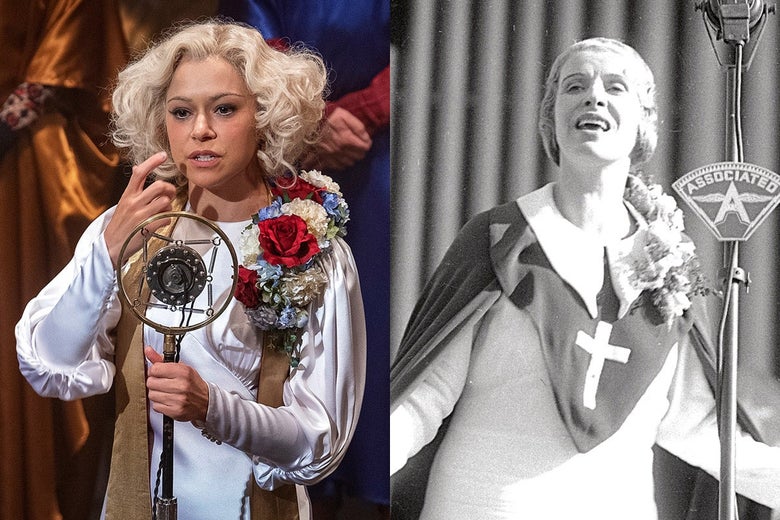
It’s a very California church even for California, involving costumes, pageantry, and radio, and it’s all clearly inspired by the real life and career of Aimee Semple McPherson, a radio evangelist who played an enormous role in the civic life of Los Angeles in the 1920s and 1930s!
To understand Sister Alice, it helps to understand the strange story of the preacher she’s based on, which involves a still-mysterious kidnapping and even wilder theatrics.
And to understand Sister Aimee, it helps to understand her backstory.
On Perry Mason, the Radiant Assembly of God’s church uses the façade of the Second Church of Christ, Scientist in West Adams, which has its own columns, though not quite as many as Angelus has.
The main sanctuary of Angelus Temple, often credited as the first American megachurch, could accommodate 5,300 people, with loudspeakers installed outside to accommodate overflow, a detail shown on Perry Mason.
In 1924, she launched her own radio station, KFSG—the call sign stands for “foursquare gospelâ€â€”and erected two gigantic radio towers atop the temple.
The investigation that followed uncovered considerable evidence that Sister Aimee had in fact run off with her lover, an employee and radio engineer named Kenneth Ormiston.
By Perry Mason’s era, McPherson had more or less weathered the storm, and Angelus Temple was a well-known tourist destination!
In Perry Mason’s second episode, Sister Alice delivers a sermon apparently based on 1 Corinthians 10:21 and “illustrates†it by having seven women onstage with her wearing robes labeled with the names of the seven deadly sins.
(There’s also someone on stage wearing biblical robes and a long fake beard, swinging around a gigantic prop pocket watch, whose presence isn’t explained but is probably related to the New Year.) It’s a pretty wild service, but Sister Alice has nothing on Sister Aimee.
Footage of McPherson’s illustrated sermons at Angelus Temple is hard to come by, but silent footage of services there proves that they were at least as raucous as the ones shown on Perry Mason:?
Perry Mason’s Sister Alice doesn’t correspond perfectly with Sister Aimee.
You can get a sense of that from this newsreel outtakes from 1929, in which McPherson observes, “Aimee Semple McPherson and the name Angelus Temple have sometimes … seemed synonymous with trouble and with tests†before telling an earlier version of what would eventually become Christopher Walken’s “Two Little Mice†speech from Catch Me if You Can:.
In Barse Miller’s 1932 painting Apparition Over Los Angeles, she’s floating in the sky over Angelus Temple, accompanied by clouds shaped like moneybags.
This year, she’s having a bit of a television revival: Both Perry Mason and the current season of Penny Dreadful feature McPherson figures
The Foursquare Church still has congregations across the country, and Angelus Temple still has weekly services in Echo Park, but Sister Aimee lives on where she always belonged: Hollywood
